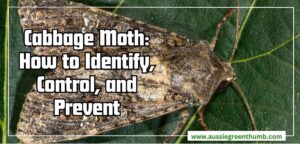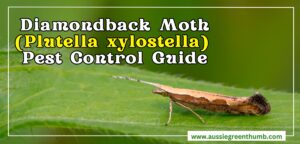Fungus gnats are a persistent problem for Australian gardeners but are particularly worrying on houseplants. While they don’t do much direct damage themselves, they spread fungal disease between plants, and thrive in damp soil – which as we all know, is a prerequisite for keeping most houseplants happy through an Aussie summer.
We’ve had recurring problems with fungus gnats for years (we’re not far from quite scrubby parkland, so they come in from there), so splashing out on expensive fungus gnat treatments isn’t an option.
In this guide, I’ll share some of the most effective DIY Treatments for fungus gnats, as well as a few tips on how to use them from experience.
More...
Superfamily: | Sciaroidea |
|---|---|
Family: | Bolitophilidae, Diadocidiidae, Ditomyiidae, Keroplatidae, Mycetophilidae, Sciaridae |
Common Names: | Fungus Gnats, Sciarid Flies |
Type: | Winged, mostly herbivorous flies |
Size: | 2-3 mm long |
Key features: | Winged adults, mostly translucent red to brown bodies (though some species differ) |
Colour: | Green |
Effects: | Carry fungal pathogens between plants, pierce leaf surfaces |
Prevention: | Predators, Deterrent plants, Organic pesticides |
What are Fungus Gnats?

Fungus gnats are small, but not insignificant, pests that lay eggs in damp soil, and develop into flying insects that feed on composting organic matter and fungus, and mostly by accident, the young roots of plants.
For veggie gardeners, they can be a nightmare, because they hatch from compost, and can quickly damage seedling roots. For houseplant growers, they are most noticeable in early spring, when they damage new roots of soft-stemmed plants like monstera or peace lilies (but will quite happily eat anything else too).
Most species of fungus gnats (and there are thousands) feed on rotting materials like fallen leaves of bark mulch, and will never cause a problem, but the ones we find on our houseplants are the most noticeable, and most problematic.
Fungus Gnat’s Natural Habitat
Fungus gnats don’t have a particular habitat, as they evolved widely to cope with all possible climates millennia ago. Today though, there are some more diverse species, particularly in Australia and New Zealand, including glowworms, which will feed on both rotting materials and fresh roots.
In terms of their preferred situation though, it's damp compost. Their larvae struggle to cope in dry conditions, so you can limit their development by watering from the base in trays, leaving the top inch of compost dry (not suitable for all plants, but good for some).
Plants Do Fungus Gnats Affect
Fungus gnats are indiscriminate feeders but are particularly fond of flowering and fruiting plants. Flowering houseplants like peace lilies are always at risk, but once they’re there, they will feed on anything from Alocasia to an Easter cactus.
Any containerised indoor plants, particularly in higher than average humidity, are at risk of fungus gnats, as their soil will be very hard to keep dry without stressing the plant, but it is possible.
How to Identify Fungus Gnats
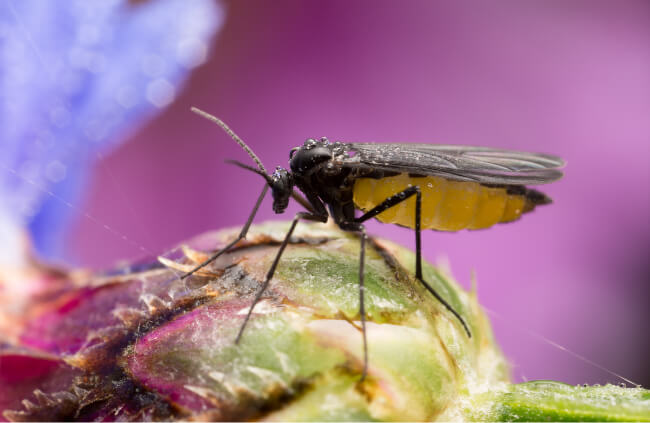
Fungus gnats come in many colours, but are generally one shape, and one size. Adult flies are about 2 mm long (3 mm if you include the antenna), with sleek, transparent wings pinned tightly to their backs when not in flight.
Their six legs all protrude from their short round thorax, with a thin pointed abdomen at the rear. Fungus gnats have small heads with long beaded antennas, which are quite distinct up close, and easy to identify.
How to Spot Fungus Gnats
A severe infestation of fungus gnats will be instantly identifiable as they can swarm in their hundreds. One or two can be harder to spot, so check for signs of pale patches developing on your plants’ foliage as a result of root damage
If the flies were carrying bacteria or fungal pathogens, those patches can develop into yellow or brown spots that eventually join up to cause swathes of verticillium wilt or similar fungal disfigurements.


Get Your Free Guide:
Master Growing Australian Natives eBook
A Must Have Complete Guide for Every Australian Garden
Get Your Free Guide:
Master Growing Australian Natives eBook
A Must Have Complete Guide for Every Australian Garden
Check around the surface of the compost by disturbing it gently. If there are flies hiding there, or larvae, they will be in the top inch of soil.
Where to Find Fungus Gnats on Plants
Fungus gnats tend not to stay on plants after feeding. They move on, and like most flies head to a bright spot. In our house, we tend to find them in groups on a bright window, or hiding around the base of a stem sat on damp compost.
What Causes Fungus Gnats?

In homes without plants, indoor fungus gnats are generally an indicator of damp issues, but if you’ve got houseplants it's almost definitely due to the surface of your houseplant soil being too wet.
Now, it's all well and good to give a general statement about overwatering, but every house plant requires different care. Some do best in damp soil, others are more drought-tolerant. Some root deeply, and others root close to the surface, so require the soil surface to have at least some moisture.
Outdoors, fungus gnats are more prevalent in shady conditions, or on mulched ground, where they can access damp soil with moisture trapped by bark chips or gravel.
The key factors that make your houseplants so appealing to fungus gnats are simple:
- Trapped moisture
- Shelter
- Protection from predators
Trapped moisture means they have their ideal environment, while shelter provided by the leaves makes sure that moisture stays for longer. And perhaps the issue most overlooked is a lack of predators.
Houseplants are grown in effective deserts that we create, where predatory insects and birds simply don’t exist. There’s very little you can do about that, but you can take on that role with a few simple DIY hacks that we’ll get to later.
How to Prevent Fungus Gnats
Fungus gnats are quite hard to prevent, but there are some simple things you can change about the way you garden that can slow them down. For example, mycorrhizal fungi has become a popular product for gardeners, and is now used widely as a root growth support.
For outdoor plants, like trees and shrubs, it's very useful for houseplants in containers, it has very little purpose. Because fungus gnats feed on fungus, all you’re doing by adding it to your planting process is offering them a free meal.
Other than that, there are some simple organic tips that can help reduce fungus gnats and even stop them entirely.

Plants that Prevent Fungus Gnats
Any plants with pungent essential oils, like lavender or rosemary, will reduce fungus gnats, but they are better at protecting themselves than other plants. Remember, fungus gnats feed on roots, not foliage, so while they won't affect the scent roots of oily herbs, they’re not usually put off from laying as a result.
Growing thyme as ground cover can work, but outdoors only as thyme tends to act as a mulch indoors, providing even more moisture (which can have the opposite effect).
How to Care for Plants to Prevent Fungus Gnats
The best way to stop fungus gnats from laying, hatching, or developing in your houseplant compost is by watering from below. If you've not done it before, it sounds odd, but trust me, it works.
All you need is a water-tight tray, large enough to fit a few plants in at a time (growing trays like this works best). Place your house pants in the tray when they need watering, and rather than watering the soil, fill the tray with water.
After half an hour, take the plants out of the tray, and the soil surface should be slightly moist, while the base of the pot is dripping wet. This encourages young plants to root downwards and stops the surface soil from staying wet for too long.
Note: This method isn’t suitable for cacti, orchids, hoya, or rubber figs – all of which are shallow-rooted and will struggle to get the nutrients or water they need this way.
How to Get Rid of Fungus Gnats
Fungus Gnat Treatments
OK, so we’ve covered how to prevent them, but how do you get rid of fungus gnats once they’ve settled in? We’ve tried so many options over the years, and they all work to an extent, so you should be able to try at least one effective DIY fungus gnat treatment from this selection today with just a few simple ingredients you already have.
Homemade Treatments for Fungus Gnats
1. Create a bottle trap
Create a DIY trap using an old plastic bottle like a water bottle or soft drink bottle. Begin by cleaning the bottle thoroughly, then sever the top part. Use a permanent marker to indicate the middle of the bottle, which will be your filling guide.
Invert the removed top and situate it back into the bottle. This design allows gnats easy entry but makes their exit challenging. Place this device on your kitchen countertop or in other areas where gnats tend to gather.
DIY recipes to fill in your bottle trap, small jar, cup or small container:
Of everything we’ve ever tried, apple cider vinegar is the most effective treatment for fungus gnats. While it isn’t instant, it is effective and provides a semi-long-term solution for dealing with these problematic pests.

i) Apple cider vinegar and sugar - two tablespoons of apple cider vinegar, a tablespoon of sugar, and approximately six drops of liquid dish soap. Give it a stir to help dissolve the sugar.
This sweet concoction attracts gnats, but the sticky soap makes their escape near impossible once they land for a sip. Optional to add half a cup of warm water, to get some more volume, depending on size of your trap.
The fungus gnats will be unable to resist the sweet and pungent scent of fermented vinegar. The dish soap sticks to them, and they drown.
This continues to work on newly hatched larvae, so leaving a cup in place for a few weeks will break their lifecycle, and rid your home of them (and as a bonus, it catches fruit flies too)
ii) Apple cider vinegar and honey - Very similar to the gnat recipe above but this time we will use honey instead of sugar. So add two tablespoons of apple cider vinegar, a teaspoon of honey and around 6 drops of dish soap. Give it a mix. Optional to add warm water, for volume.
iii) Sugar and white vinegar - Mix 3 tablespoons of sugar with 1/4 cup of white vinegar until completely dissolved, add some drops of dish soap then pour this concoction into the bottle. Top up with water until you reach the marked line.
iv) Red wine - use an unfinished bottle or buy a cheap bottle of red wine and let it expire (no point using a nice one). Pour into the bottle trap or container, add a couple drops of dish soap and the gnats will be attracted to the smell and get drunk and drown?
2. Homemade flypaper
Flypaper is expensive, but it's also effective. If you want to make your own, it takes a bit of time for drying, and preparation, but it's a useful way to stop flies from entering or extending their lifecycle.
Unlike other options, this isn’t a reusable or long-term option and you will need to make more every week to keep catching them as they hatch out.
Start with yellow sticky notes (nearly all flies, including fungus gnats, are attracted to yellow). Then mix a cup with equal parts corn syrup caster sugar and water (you can swap corn syrup for honey).
Boil the mixture just until the sugar dissolves, then leave to cool slightly. Coat the sticky notes in the mixture, and hang them with pegs around the house once they’ve cooled.
3. Hydrogen Peroxide
An instant fungus gnat killer is hydrogen peroxide. A basic 3% solution (available at most chemists) is suitable. The problem with this is that it will dry out plant leaves if you don’t wash the residue off afterwards.
The benefit is that it is selective, and you can apply it directly to flies using a cotton bud, which will dry them out and kill them in seconds.
It also won’t have any effect on larvae if they have already laid, so pair this with the absorption watering method from earlier to help dry out the top layer of soil and interrupt larval development.
4. Cinnamon (various forms)
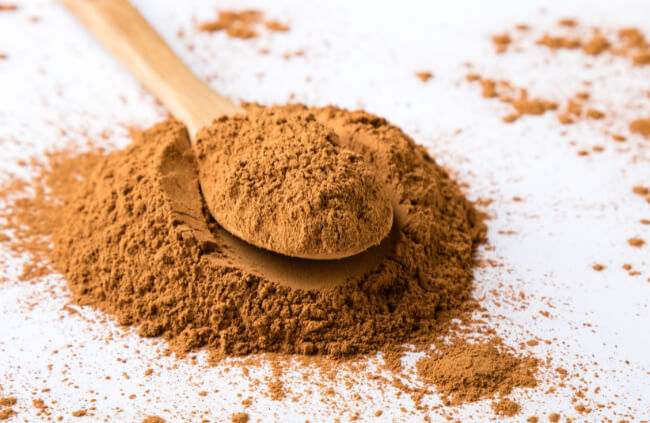
If in doubt, go for the food source! Cinnamon is highly antifungal, and ground cinnamon powder, sprinkled onto the compost of your house plants will smell good, and rude fungal activity on the compost.
If fungi aren’t present, there's nothing for fungus gnats to eat. While this is never 100% effective, repeat treatments over time will make your home less attractive to the gnats.
5. Neem oil and castile soap
Neem oil and castile soap is a classic houseplant pest treatment. I’m uneasy about suggesting it for outdoor use, as it is a spray insecticide that will harm pollinators. For indoor use though, there is no danger of harming pollinators, so you can use this organic, homemade fungus gnat treatment whenever you need to!
Simply mix a capful of each into a 1L spray bottle of warm water and leave it to cool. Then spray it onto the soil surface, or onto any visible fungus gnats. It will also work on most houseplant pests (though is less effective on scale insects, which will be weakened, but not killed).
6. Lavender essential oil

Lavender essential oil, while less antifungal than cinnamon, does share some antifungal effects. It’s also a general repellant to fungus gnats, who dislike the odour.
Adding a few drops to water, then misting the soil surface can be enough to stop them from laying on houseplant pots and containers. We’ve had mixed results with this method, but it has been effective when paired with other preventative solutions.
7. Sand
Sand might seem too simple but it is a very effective mulch that stays dry, drains well, and does no harm to your plants. Rather than mulching with bark, grit, or compost (which all create shade and shelter for fungus gnats) using 2 cm of horticultural-grade sand (anything other than play sand or builder’s sand) as a mulch on your houseplants means that fungus gnats, and the fungus they feed on, has nowhere to go.
It is simple, but it’s truly effective. Any existing larvae will still hatch out, but they won't lay there again, so in a few weeks the problem will be gone entirely.
The only warning with this method is that it can weigh down and compost soil, and it means you don’t have access to compost to check moisture levels, which can lead to overwatering and other problems.
Effective Organic Store-Bought Fungus Gnat Treatments
If you’re happy to pay for fungus gnat treatments and don’t want the hassle of making your own, there are a few effective store bought gnat treatments available:
Raid Fly Traps
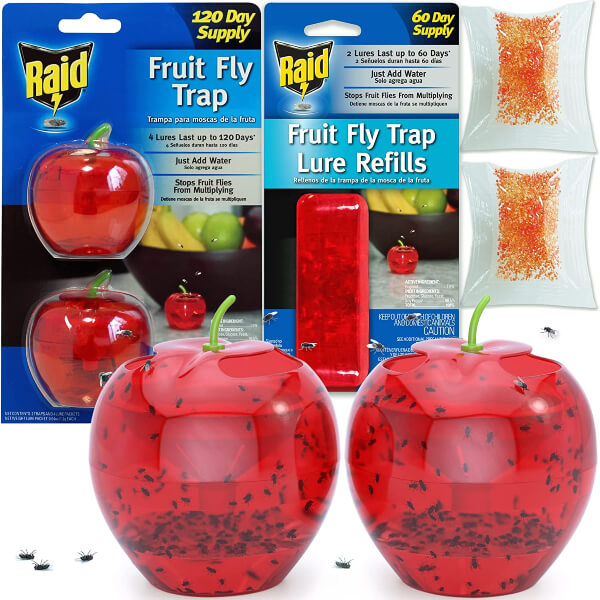
Raid doesn’t do organic, they do effective. Pretty much any raid product will be effective against fruit flies, but if you want one that you can keep out of reach of kids, and don’t need to worry about fumes, try these fruit fly traps, which are refillable, and effective.
They work the same way as the vinegar traps but are much easier to set up.
Get this Fruit Fly Killer & Gnat Trap Here
Indoor Electric Fly Traps
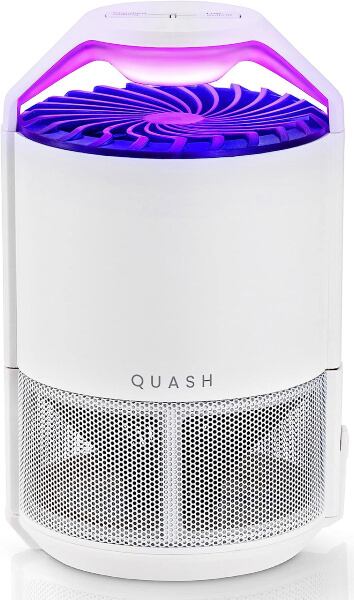
For a chemical-free alternative, try an electric bug zapper, like the QUASH indoor insect trap, which attracts fungus gnats and fruit flies to the light and sucks them into a sticky trap with refillable pads.
It lasts longer, and over your lifetime will cost less than most other store-bought options too.
Get this QUASH Indoor Insect Trap Here
Fly Paper

There are a few brands of fly paper out there, from the budget-friendly Stingmon multipacks, which can last up to a year, to the more expensive (and more effective) Flower-mimicking fly papers from Safer Brand or Garsum.
When it comes to fly paper, the longer it lasts, the more effective it’ll be. Like most animals, flies are more comfortable either with very shiny, pheromone-rich objects, or bright lights, or things they're familiar with.
If fly paper dries out too quickly it becomes ineffective, so for the best longevity go for something slightly more expensive like the Garsum or Safer Brand fly papers, which also mimic flowers, and look less threatening to fungus gnats.
If you’re willing to wait and replace them more regularly, try Stingmon’s budget pack, which gives you 48 sheets of fly paper. If they do dry out before they catch anything, you can reactivate them by gently misting them with water.
Fungus Gnat Frequently Asked Questions
What kills fungus gnats instantly?
Hydrogen peroxide kills fungus gnats instantly, but it doesn’t kill the larvae in the soil. For that, you’ll need a longer-lasting solution, which can be as simple as vinegar and dish soap, or homemade fly paper.
Are fungus gnats bad for your health?
Fungus gnats are not bad for your health. They pose no risk to humans and do not bite. As a result, they don’t carry human bacteria or disease. Their only risk is to houseplants and garden plants which are affected by soil borne fungi and diseases that they carry and spread.
Do fungus gnats mean I have mould?
If you have fungus gnats at home and have no houseplants, then it is quite likely that there is damp or mould in your property, as they require damp conditions and living fungus to feed.
They are attracted to the smell of mould, and can sense it long before we can, so follow the flies, and you may well find your damp!
Will fungus gnats go away on their own?
Fungus gnats won’t go away on their own. They will continue laying in the same spot, and in nearby containers until you deal with them. The longer you leave it the more damage they are likely to do to your plants.
For more pest identification and treatment guides, check out our list below:
Wrapping Up Our Guide on How to Get Rid of Fungus Gnats
Fungus gnats are pests because they’re clumsy. That’s really what it comes down to. They are, as their name suggests, attracted to damp conditions, where fungus thrives. If you provide those conditions in your houseplant compost, fungus gnats will come, and they will eat anything that is attached to that fungus.
The problems arise when the soil is routinely humid enough for fungi to attach to roots. Once that happens, it's hard to fix, but by treating the soil, allowing it to dry out, and adding organic anti-fungal ingredients like cinnamon or lavender oil to the compost, you stand a good chance of getting rid of fungus gnats, and fixing your plants, all in one go.
Published on June 22, 2023 by Gary Clarke
Last Updated on December 11, 2023



